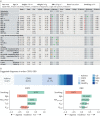Collaboration between explainable artificial intelligence and pulmonologists improves the accuracy of pulmonary function test interpretation
- PMID: 37080566
- PMCID: PMC10196345
- DOI: 10.1183/13993003.01720-2022
Collaboration between explainable artificial intelligence and pulmonologists improves the accuracy of pulmonary function test interpretation
Abstract
Background: Few studies have investigated the collaborative potential between artificial intelligence (AI) and pulmonologists for diagnosing pulmonary disease. We hypothesised that the collaboration between a pulmonologist and AI with explanations (explainable AI (XAI)) is superior in diagnostic interpretation of pulmonary function tests (PFTs) than the pulmonologist without support.
Methods: The study was conducted in two phases, a monocentre study (phase 1) and a multicentre intervention study (phase 2). Each phase utilised two different sets of 24 PFT reports of patients with a clinically validated gold standard diagnosis. Each PFT was interpreted without (control) and with XAI's suggestions (intervention). Pulmonologists provided a differential diagnosis consisting of a preferential diagnosis and optionally up to three additional diagnoses. The primary end-point compared accuracy of preferential and additional diagnoses between control and intervention. Secondary end-points were the number of diagnoses in differential diagnosis, diagnostic confidence and inter-rater agreement. We also analysed how XAI influenced pulmonologists' decisions.
Results: In phase 1 (n=16 pulmonologists), mean preferential and differential diagnostic accuracy significantly increased by 10.4% and 9.4%, respectively, between control and intervention (p<0.001). Improvements were somewhat lower but highly significant (p<0.0001) in phase 2 (5.4% and 8.7%, respectively; n=62 pulmonologists). In both phases, the number of diagnoses in the differential diagnosis did not reduce, but diagnostic confidence and inter-rater agreement significantly increased during intervention. Pulmonologists updated their decisions with XAI's feedback and consistently improved their baseline performance if AI provided correct predictions.
Conclusion: A collaboration between a pulmonologist and XAI is better at interpreting PFTs than individual pulmonologists reading without XAI support or XAI alone.
Copyright ©The authors 2023.
Conflict of interest statement
Conflict of interest: N. Das holds a patent on automated quality control of spirometry. E. Derom reports consultancy fees from Chiesi, GlaxoSmithKline, AstraZeneca and Boehringer Ingelheim. G. Brusselle reports payment or honoraria for lectures from AstraZeneca, Boehringer Ingelheim, Chiesi, GlaxoSmithKline, Novartis and Sanofi. F. Burgos reports consultancy fees from Medical Graphics Corporation Diagnostics. M. Contoli reports grants from the University of Ferrara, Chiesi and GlaxoSmithKline, consultancy fees and honoraria from AstraZeneca, Boehringer Ingelheim, Chiesi, GlaxoSmithKline and Novartis, as well as support for attending meetings from Chiesi, AstraZeneca, GlaxoSmithKline and ALK-Abelló. W.D-C. Man is part funded by a NIHR Artificial Intelligence Award, and reports grants from the NIHR and British Lung Foundation, as well as honoraria from Mundipharma, Novartis, European Conference and Incentive Services DMC; and is the Honorary President of the Association for Respiratory Technology and Physiology (ARTP, UK). J.K. Quint reports grants from the MRC, HDR UK, GlaxoSmithKline, AstraZeneca and Chiesi, and consultancy fees from Insmed and Evidera. E. Vanderhelst reports grants from Chiesi, and consultancy fees and honoraria from Boehringer Ingelheim, Vertex and GlaxoSmithKline. M. Topalovic is part funded by a NIHR Artificial Intelligence Award, and is co-founder and shareholder of ArtiQ. W. Janssens reports grants from Chiesi and AstraZeneca, consultancy and lecture fees from AstraZeneca, Chiesi and GlaxoSmithKline, and he is co-founder and shareholder of ArtiQ. The remaining authors report no potential conflicts of interest.
Figures


Comment in
-
Artificial intelligence: do we really need it in pulmonary function interpretation?Eur Respir J. 2023 May 18;61(5):2300625. doi: 10.1183/13993003.00625-2023. Print 2023 May. Eur Respir J. 2023. PMID: 37208036 No abstract available.
References
-
- Johnson JD, Theurer WM. A stepwise approach to the interpretation of pulmonary function tests. Am Fam Physician 2014; 89: 359–366. - PubMed
Publication types
MeSH terms
LinkOut - more resources
Full Text Sources
Medical
